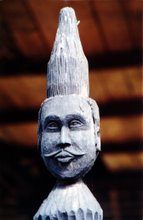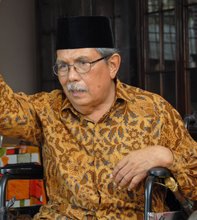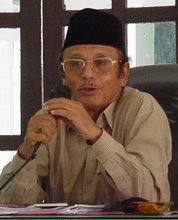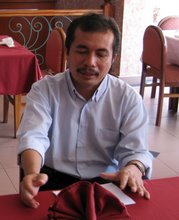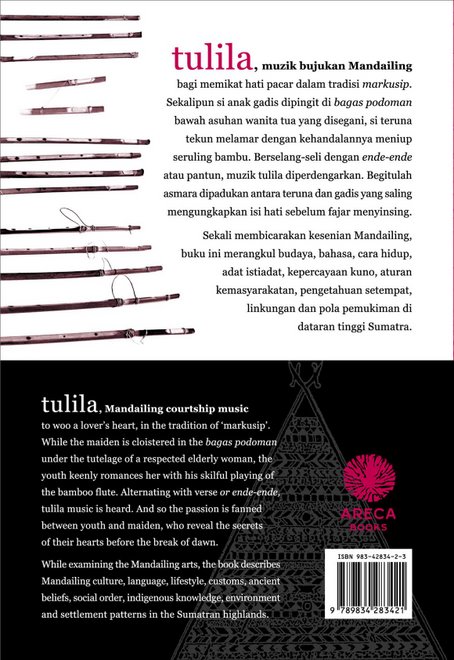 Gopeng Contingent starting for the Pahang War May 1892 under Imam Prang [Jabarumun]. Taken on A.D.O. (Assistant District Officer) Tennis Court.
Gopeng Contingent starting for the Pahang War May 1892 under Imam Prang [Jabarumun]. Taken on A.D.O. (Assistant District Officer) Tennis Court.Kontinjen Gopeng berlepas untuk Perang Pahang Mei 1892 di bawah [kepimpinan] Imam Perang [Jabarumun]. Diambil di Laman Tenis Asisten Pegawai Daerah.
Indonesia 80 (October 2005)
Abdur-Razzaq Lubis and Khoo Salma Nasution.
Raja Bilah and the Mandailings in Perak: 1875-
1911.
Kuala Lumpur: Malaysian Branch of the Royal Asiatic Society, 2003. 278 pp.
Susan Rodgers
This fact-stuffed, quickly paced biography of an entrepreneurial Mandailing immigrant from Sumatra to colonial Malaya during the tin-rush years of the late 1800s goes considerably beyond a simple narration of a life. Therein lies the volume's value to scholars of both Indonesia and Malaysia-nations that this study implicitly suggests should be observed in the same research framework, as densely linked former colonies. As a monograph, Raja Bilah and the Mandailings in Perak reads as a somewhat unfinished piece of work since it includes so much text that reproduces original sources (letters, land surveys, mining permits). But, the study as a whole carries a useful message: the suggestion that minutely detailed local histories of this sort on Malaysian economic and social history can point toward broader interregional frameworks for conceptualizing the history of places like colonial Perak in British Malaya and colonial north and west Sumatra in the Dutch East Indies. The authors do not explicitly suggest that larger framework, but Raja Bilah's life story cries out for such follow-up, comparative research. Topics here might include a comparative, Dutch East Indies / British Malaya approach to late nineteenth-century immigration across the Straits of Malacca. Or, a similar comparison of colonial-era mining communities in this region in relation to such matters as labor violence. Or, a cross-straits inquiry into the remarkably fluid social-identity universes in colonial Malaya and the Indies that led a "Batak" (often a contentious ethnic tag) like Raja Bilah to move from being a "Mandailing" in Sumatra to becoming (at times) a "foreign Malay" in Perak. Such social journeys come alive in descriptive biographies of this sort.
The undigested nature of the book's narration is quite defensible in some ways. The volume offers readers a wealth of original sources and, on that score, will probably "teach well" to classes in historiography. Raja Bilah was a Mandailing high aristocrat from the Nasution clan, born in the Tapanuli north Sumatra town of Maga in about 1834. His famous uncle was Raja Asal, who had been the leader of peninsular Malaysia's large numbers of Mandailing emigres from the 1840s until his death in 1877. These immigrants had fled the violence of the Padri Wars (1821-37) to seek a better life in Malaya. In Padri times, the Dutch East Indies military attempted to contain Wahabhist-led expansion by Minangkabau militants and Muslim proselytizers into the southern Batak regions of Angkola and Mandailing. These regions were then both impoverished and dangerous. Soon after, the Dutch state's onerous corvee labor demands (fifty-two days of work per year, in Mandailing) pushed more migrants across the Straits.
Upon Raja Asal's death, Raja Bilah became the head of this growing emigre Mandailing community. He surpassed his uncle in political and business craftiness because his career intersected with the tin-mining boom in Malaya. He was "the right foreign Malay" in the right place at the right time to prosper mightily.
After performing favors for the British administrators in the pacification of Perak, Raja Asal was richly rewarded. The British appointed him penghulu, or community leader; they made him a tax collector; they befriended his family. And, most profitably, they gave him special access to developing tin mines in the Papan region. Mandailing managers led by Raja Bilah went on to forge strategic alliances with Chinese miners and their labor organizations. Although Raja Bilah suffered cash-flow problems at times, as the Perak tin industry was subject to the fluctuations of the value of tin on the international market, overall he and his family prospered, as "foreign Malays" associated with the British. The latter saw their Mandailing associates as notably "hardworking" (not to mention, expert agriculturalists). The colonial officials apparently saw the Mandailing as natural managers, in contrast to the more reviled "lazy Malays."
To document Raja Bilah's life and that of his large extended family (also a focus of the book), the authors present readers with photographed reproductions of the following: mortgage deeds; Jawi script letters in the original, with translations; old maps and mining surveys; news stories from business gazettes; and drawings by travelers. A caption for one of the latter wonderfully enough relates a trip that one of Raja Bilah's relations took into elephant territory. The young man, Abu Bakar, from Deli in East Sumatra, reports on "elephant language." These are the words that an elephant trainer would use to speak to his charges. Readers learn that to tell an elephant to sit down, one must say "Turum-turum" (146).
The book's roster of original sources also includes such minutiae as receipts for charcoal. The volume fairly bursts with such source texts, in fact, and is also illustrated with dozens of archive photographs. Abdur-Razzaq Lubis is related to Raja Bilah through his grandmother and enjoyed special access to family photographs and letters. The Toyota Foundation in Malaysia sponsored the research by Lubis and his coauthor Khoo Salma Nasution (who is Lubis's wife). The study ends with appendices on Raja Bilah's family tree and his children and grandchildren.
The major players throughout the book's twenty-seven brief chapters are Malay sultans (often jealous of successful foreign Malays like Raja Bilah), prominent British civil officials, and other Mandailing noblemen and noblewomen intent on business success in Perak. The generation-to-generation trend was for Raja Bilah's Mandailingin-Malaya contemporaries to work with the British to develop the mines; then for the next generation to branch out into shopkeeping and tin brokering; then for the third generation to enter such fields as (Malay-language) journalism.
Readers also learn of the labor violence in the tin mines at the end of the era of Chinese secret societies. At one point in the story, Raja Bilah's gun-toting wife Ungku Nai mas endeavors to defend some Chinese women and children who had sought her out as a protector (107). The development of tin mining in the Kinta Valley, in sum, emerges in this enjoyable text as apt material for movies.
Comparative studies research of a more formal historical or anthropological sort might push beyond this lavishly descriptive text to ask questions like the following. What can the history of Raja Bilah's family and its successive social-identity shifts tell scholars of the "Batak peoples" in Indonesia? Southern Batak from Angkola, and particularly those from Mandailing, sometimes dropped their diagnostically Batak clan names when they moved to the Deli plantation belt in east coast Sumatra from the 1880s forward. These immigrants thereby "masuk Melayu," that is, they entered Malayhood and became Malay. The large scholarship on this migration phenomenon within Indonesia rarely takes the Malaysian experience of families like that of Raja Bilah into account. Conversely, Lubis and Nasution's research would benefit from taking that same broader perspective-inquiring into the scholarship on Mandailing identity politics in the Indies and Indonesia and then bringing that back to the study of Mandailings in Malaysia. The authors provide fascinating material on former Indonesian vice president Adam Malik's family (a Mandailing family with ties to Perak who "became Malay" and dropped their clan name publicly). But, the authors leave the issue undertheorized.
Another promising line of inquiry would be: How can the Straits of Malacca regions of Deli and Dumai in Sumatra, and Perak and Selangor in peninsular Malaysia, be reconceptualized, specifically, as borderlands? For contemporary times, the anthropologist Johan Lindquist is exploring this idea in his work on factory-girl migrations across national boundaries to the island of Batam. But historically too, for the 1870-1930s period, the Straits of Malacca corridor seems to have formed a grand concourse for back-and-forth labor migration between places like Maga and Perak. Better known migration paths such as the one from Angkola to Deli, or from Minangkabau to Negeri Sembilan, have been studied. What this rewarding biography of this irrepressible Mandailing migrant goes on to suggest is the idea that the fuller picture will emerge only when scholars treat Malaysia and Sumatra as border regions that have long mutually constituted each other's social worlds.
